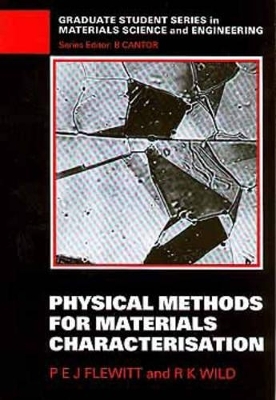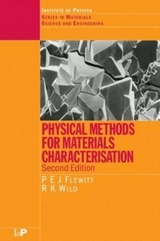
Physical Methods for Materials Characterisation
Institute of Physics Publishing
9780750303200 (ISBN)
- Titel erscheint in neuer Auflage
- Artikel merken
This important textbook provides a comprehensive description of the large range of techniques currently in use for the characterisation of the microstructure of materials.
Written for students and researchers learning new techniques, the book carefully explains the interactions between various radiations with materials, and shows how these interactions form the basis of the specific evaluation and measurement methods. Sections of the text deal with basic science and technology, such as diffraction laws, vacuum techniques and radiation sources.
The characterisation techniques are divided on the basis of the interrogating radiation source, and cover optical and x-ray techniques, electron microscopy and spectroscopy, ion and particle microscopy and spectroscopy. Computer applications in instrument control, data acquisition and analysis are discussed, together with coverage of simulation techniques. It is suitable for for final year undergraduate students and graduate courses on materials.
This series of books in Materials Science and Engineering is designed to meet the needs of graduate students and senior undergraduates. The books provide useful introductory surveys of particular areas of Materials Science and Engineering. Although not primarily resarch texts, the books point out the direction which research is currently taking and where it is expected to lead.
Physical Methods for Microstructural Characterisation provides a comprehensive description of the large range of techniques currently in use for the charactersiation of the microstructure of materials.
Introductory chapters cover the basic physics used to describe the background to materials microstructure and the interaction of various types of radiation with materials. Analysis is given for optical, x-ray and particle beam interactions, since these form the basis of the specific measurement and evaluation techniques. Much of the hardware involved is dependent on a vacuum environment, and a full chapter is devoted to this topic. The early chapters lay down the basic foundations which are incorporated in following chapters dealing with specific techniques. The characterisation techniques are divided on the basis of the interrogating radiation source, with separate chapters dealing with optical and x-ray techniques, electron microscopy and spectroscopy, and ion and particle microscopy and spectroscopy. Within each of these chapters, material is given covering the radiation sources, the construction and layout of instrumentaiton and the analysis of data. A final chapter deals with the use of computer equipment in the collection and analysis of data. The book is thoroughly illustrated with examples of analytical equipment and with the different kinds of output to be expected, together with comments on the analysis and interpretation of images and spectra.
The book is suitable as a textbook, and it is also intended that the book should act as a guide for inexperienced researchers who need to learn the best way to use a specific technique for any given groups of materials.
Physical Methods for Microstructural Characterisation will be of interest to advanced undergraduates, postgraduates and researchers in physics, materials science, and engineering.
Peter Flewitt, following a period at the Unviersity of Sheffield, joined the Central Electricity Generating Board, and he currently holds the post of Section Manager in the Technology Division of Nuclear Electric at Berkeley in Gloucestershire. He is also a Visiting Professor in the Deparment of Physics at the University of Surrey.
Bob Wild studied at Reading University before spending two years in the Physics Department of University of Virginia, USA. He returned to join the Central Electricity Generating Board, and is now Senior Research Fellow at the Interface Analysis Cenre of the University of Bristol, UK.
Interaction of particles and radiation with materials: Probing radiation; Penetration depths; Damage; Resolution; Loss processes; Atom/ion processes; Effects of high electric fields; Acoustic phenomena; References. Vacuum requirements: Introduction; Kinetic theory of gases; Production of vacuum; Pumps; Pressure management; Leak detection; Sample handling; References. Diffraction: Electromagnetic radiation; Diffraction; References. Photo/electromagnetic sources: Introduction; Resolution; Lens defects; Optical light microscopy; Laser microscopy; Acoustic microscopy; Infra-red microscopy; X-ray microscopy; X-ray topography; X-ray photoelectron spectroscopy; Mossbauer spectroscopy. Electron sources: Introduction; Scanning electron microscopy; Electron probe microanalysis; Transmission electron microscopy; Auger electron spectroscopy. Atom/ion sources: Introduction; Ion scattering spectroscopy; Proton back-scattering; Secondary ion mass spectroscopy; Sputtered neutral mass spectroscopy; Field ion microscopy; Scanning tunnelling microscopy; Particle induced X-ray emission; References. Application of computers: Instrument control; Computer aided instruction; Data acquisition; Data processing and analysis; Image quantification; Data bases; Expert systems; Computer simulations; Way forward; References.
| Erscheint lt. Verlag | 1.1.1994 |
|---|---|
| Reihe/Serie | Series in Materials Science and Engineering |
| Verlagsort | London |
| Sprache | englisch |
| Maße | 156 x 235 mm |
| Gewicht | 907 g |
| Themenwelt | Naturwissenschaften ► Physik / Astronomie ► Festkörperphysik |
| Technik ► Maschinenbau | |
| ISBN-13 | 9780750303200 / 9780750303200 |
| Zustand | Neuware |
| Informationen gemäß Produktsicherheitsverordnung (GPSR) | |
| Haben Sie eine Frage zum Produkt? |
